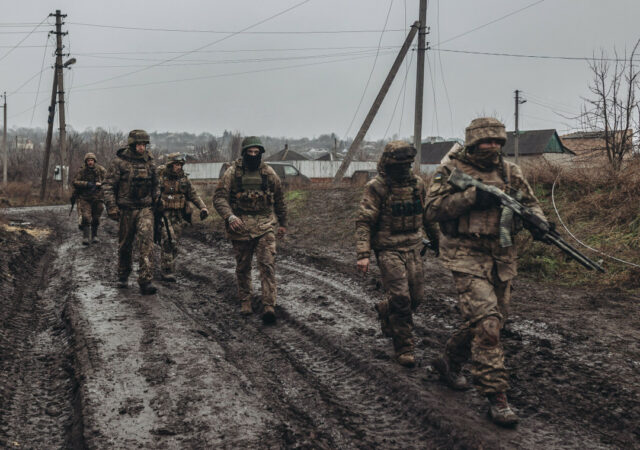
Moving the Goalposts: Russia’s Evolving War Aims in Ukraine (Part One)
Publication: Eurasia Daily Monitor Volume: 20 Issue: 41
By:

Russia’s political and military aims in Ukraine are continuously evolving throughout the course of the ongoing war. Its blitzkrieg in February and March 2022 failed to defeat and subdue Ukraine outright. Moscow accordingly reverted to the strategy and tactics of gradualism. From last March onward, Moscow has given every indication of seeking a negotiated solution, heavily weighted in Russia’s favor but still falling considerably short of its initial, maximalist objectives (see below).
Russia would currently be satisfied with a land-for-“peace” solution, based on ceasefire lines cutting across Ukraine and de facto international acceptance of (or resignation to) Russia’s territorial conquests. If so, Russian forces would not need to take another centimeter of Ukrainian territory to seal Ukraine‘s defeat, as Hans Petter Midttun points out (Euromaidan Press, March 3).
Moscow, however, would undoubtedly regard any such agreement as a temporary truce that would position Russia to pursue more ambitious goals more effectively in the next stage of the conflict.
The Kremlin’s kinetic war in Ukraine forms an inseparable part of Russia’s multidimensional, protracted conflict with the West. Indeed, at the end of 2021 and the beginning of 2022, Russia chose Ukraine as the main arena of that wider conflict. Moscow presented its ultimatum-style demands to the North Atlantic Treaty Organization (NATO), the United States and Ukraine from December 2021 to January 2022 on parallel tracks, as components of a package designed to transform the European security order in Russia’s favor. That would in turn have compromised the position of the US on the global level. Although Ukraine is not a NATO member—and for this very reason—it is in Ukraine, the permanent fulcrum of Europe’s balance of power, that Russia is now contesting what it terms “global US hegemony.”
Russia’s war aims in Ukraine are also of an internal Russian nature from the Kremlin’s perspective. During Vladimir Putin’s third presidential term, Russia reverted to its historical, proprietary attitude toward Ukraine. The Kremlin, in effect, has canceled the Soviet Union’s and post-Soviet Russia’s recognition of Ukraine’s distinctive national identity, viewing the country instead as an inalienable part of a “Russian world.” This ideological construct served Moscow to contest Ukraine’s territorial integrity during its 2014 military intervention and then to contest the foundations of Ukrainian statehood with its full-scale invasion in February 2022.
At that stage, Moscow viewed Ukraine with trepidation, as the country was moving unstoppably away from Russia. Ukrainian national identity, culture, mass media and the nationally-minded Orthodox Church were rapidly gaining ground, reversing the past processes of Russification. The Ukrainian state enacted restrictive measures on fifth-column political groups (including those with parliamentary representation), deprived some of mass-media ownership and started criminal investigations against Moscow’s closest allies in Ukraine, including Viktor Medvedchuk. The Ukrainian military was undergoing training by the dreaded “Anglo-Saxons”—albeit on a limited scale, purely defensive and outside NATO’s framework. Ukraine’s one-party government (president, parliamentary supermajority and cabinet of ministers) precluded Russia from playing factions within the government against each other. On the diplomatic level, Ukraine was firmly resisting the implementation of the Minsk “agreements,” which were possibly the last “hook” (in Moscow’s parlance) for Russia to hold onto and subvert Ukraine.
Moscow therefore concluded that only a full-scale military intervention could stop the process of “losing” Ukraine to the West. Correctly assessing that this process stemmed from a broad-based Ukrainian national consensus, the Kremlin, meanwhile, seriously overestimated the West’s willingness to integrate Ukraine into its structures in a meaningful timeframe. This overestimation added to the Kremlin’s sense of urgency in reversing Ukraine’s internal political process of de-Russification and Westernization. Reversing that process in each of its elements constituted Russia’s agenda of war aims.
Russia’s war aims basically fall into two categories. Those that Putin announced from the start of the war and has repeated to date (adjusting some of their nuances to reflect the course of the war) are the pre-programmed goals. They are maximalist goals, worked out by the Kremlin in the run-up to the all-out invasion on February 24, 2022 (see EDM, February 22, 24, 25, 2022).
An additional set of Russian war aims has emerged during the war, in consequence of the ebb and flow of military operations. These additional goals may be termed as opportunity goals for Russia. The Kremlin may have broadly anticipated such opportunities during the war-planning but did not announce them as goals at the start nor soon afterward.
The pre-programmed goals can be grouped under the general heading of extinguishing Ukraine’s national identity and viable statehood. That goal, however, can equally be seen as a means to an end: in classical terms of power politics, to reintegrate Ukraine’s territorial, economic, demographic, mineral, industrial and agricultural resources with Russia’s own—thus adding to Russia’s capacity to compete against the West and threaten Europe from forward positions in Ukraine.
That goal, however, presupposed changing the regime in Kyiv to a pro-Russian one and heavily investing in Ukraine’s economy to compensate for the loss of Western inputs. As the Kremlin-connected analyst Fedor Lukyanov points out, even if Russia had managed to turn Ukraine into a dependency it could never have sustained it economically from Russia’s own resources (Russiancouncil.ru, February 13).



